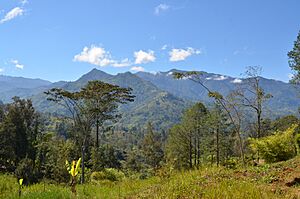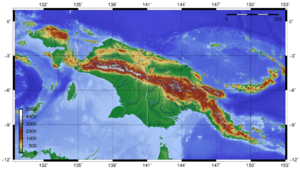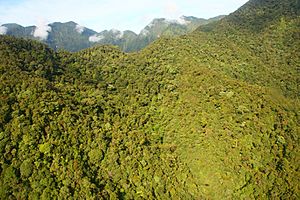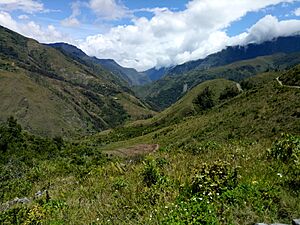New Guinea Highlands facts for kids
Quick facts for kids
New Guinea Highlands
|
|
|---|---|
|
Natural region
|
|

Landscape in the New Guinea Highlands
|
|

Topographic map of New Guinea. The New Guinea Highlands are the large mountain chain crossing almost the entire island
|
|
| Island | New Guinea |
| Area | |
| • Total | 142,840 km2 (55,150 sq mi) |
| Dimensions | |
| • Length | 1,900 km (1,200 mi) |
| • Width | 165 km (103 mi) |
| Elevation | 4,884 m (16,024 ft) |
The New Guinea Highlands is a huge chain of mountain ranges that stretches across the island of New Guinea. It's also called the Central Range or Central Cordillera. This area is home to Puncak Jaya, the tallest mountain in Oceania, located in Indonesia. Many river valleys wind through these mountains. These valleys are home to many farming communities. The highlands run from east to west across the island. The island is split between Indonesia in the west and Papua New Guinea in the east.
Contents
Exploring the Geography of New Guinea Highlands
The Central Cordillera is a long mountain chain. Some of its peaks are even covered with ice! It includes several important ranges. In Papua New Guinea, you'll find the Central Highlands and Eastern Highlands. These include the Owen Stanley Range with Mount Victoria (4,038 meters or 13,248 feet). Also, there are the Albert Victor Mountains, the Sir Arthur Gordon Range, and the Bismarck Range. The highest peak in the Bismarck Range is Mount Wilhelm (4,509 meters or 14,793 feet). This mountain is an extinct volcano with a lake in its crater.
Moving west, you'll find the Star Mountains right on the border between Papua New Guinea and Indonesia. In Indonesia, there are the Maoke Mountains, also known as the Snow Range. Here, explorer H. A. Lorentz found permanent snow in 1909. The tallest peaks in this area are Puncak Jaya (4,884 meters or 16,024 feet), Puncak Mandala (4,760 meters or 15,610 feet), and Puncak Trikora (4,750 meters or 15,580 feet).
While some valleys, like the Waghi Valley in the Western Highlands of Papua New Guinea, are heavily farmed and have towns, most mountain areas have traditional tribal villages. These villages are found in the grassy mountain valleys.
The highland provinces in Papua New Guinea include:
- Eastern Highlands Province
- Simbu Province (or Chimbu), known for coffee farming
- Jiwaka Province
- Western Highlands
- Enga Province, home to the Enga people and the large Porgera Gold Mine
- Hela Province
- Southern Highlands Province, known for the Huli wigmen
- Parts of West Sepik Province and Western Province
The Highlands Highway connects many of these towns. Bigger towns in the PNG Highlands are Mount Hagen, Goroka, and the mining town of Tabubil. The climate is humid, like most tropical rainforest islands. However, the higher mountain slopes are much cooler than the lowlands.
The Highlands are also the source of several important rivers. These include the Sepik River and Ramu River to the north, and the Fly River to the south. There are also lakes like Lake Kutubu, where oil has been extracted since 1992.
Tallest Peaks in the New Guinea Highlands
Here are some of the highest mountains in the New Guinea Highlands:
| Mountain | Elevation |
|---|---|
| Puncak Jaya | 16,024 ft (4,884 m) |
| Sumantri | 15,980 ft (4,870 m) |
| Ngga Pulu | 15,951 ft (4,862 m) |
| Carstensz East | 15,810 ft (4,820 m) |
| Carstensz Timur | 15,758 ft (4,803 m) |
| Puncak Mandala | 15,620 ft (4,760 m) |
| Puncak Trikora | 15,580 ft (4,750 m) |
| Ngga Pilimsit | 15,476 ft (4,717 m) |
| Middenspits | 15,426 ft (4,702 m) |
| Mount Yamin | 14,900 ft (4,541 m) |
| Wachter | 14,865 ft (4,531 m) |
| Gunung Speelman | 14,859 ft (4,529 m) |
| Mount Wilhelm | 14,793 ft (4,509 m) |
| JP Coen Peak | 14,764 ft (4,500 m) |
| Valentijn Peak | 14,609 ft (4,453 m) |
| Mount Giluwe | 14,327 ft (4,367 m) |
| Mount Kubor | 14,301 ft (4,359 m) |
| Mount Boising | 13,615 ft (4,150 m) |
| Mount Bangeta | 13,520 ft (4,120 m) |
| Mt. Kabangama | 13,464 ft (4,104 m) |
| Mount Victoria | 13,248 ft (4,038 m) |
| Mt. Albert Edward | 13,091 ft (3,990 m) |
| Mount Capella | 12,992 ft (3,960 m) |
| Mount Hagen | 12,395 ft (3,778 m) |
| Mount Suckling | 12,060 ft (3,676 m) |
| Mount Michael | 11,965 ft (3,647 m) |
| Mount Arfak | 9,695 ft (2,955 m) |
| Mount Bosavi | 8,225 ft (2,507 m) |
Major Rivers of the New Guinea Highlands
Here are some of the longest rivers in the New Guinea Highlands:
| River | Length |
|---|---|
| Sepik River | 1,146 km (712 mi) |
| Mamberamo River | 1,112 km (691 mi) |
| Fly River | 1,060 km (660 mi) |
| Digul River | 853 km (530 mi) |
| Strickland River | 824 km (512 mi) |
| Taritatu River | 808 km (502 mi) |
| Purari River | 710 km (440 mi) |
| Ramu River | 640 km (400 mi) |
| Tariku River | 488 km (303 mi) |
| Wawoi River | 482 km (300 mi) |
| Kikori River | 445 km (277 mi) |
| Baliem River | 414 km (257 mi) |
| Pulau River | 403 km (250 mi) |
| Turama River | 302 km (188 mi) |
| Apaoewar River | 267 km (166 mi) |
| Wahgi River | 243 km (151 mi) |
| Erave River | 224 km (139 mi) |
| Ok Tedi River | 207 km (129 mi) |
| Markham River | 180 km (110 mi) |
| Kumusi River | 167 km (104 mi) |
| Gami River | 160 km (99 mi) |
| Ka River | 152 km (94 mi) |
| Aikwa River | 128 km (80 mi) |
| Kaugel River | 113 km (70 mi) |
How the New Guinea Highlands Were Formed
These mountains are still growing! The Australian Plate is slowly crashing into other plates to the northeast. This collision causes the mountains to rise and also leads to earthquakes. The mountain range changes in width. It's quite thin in the middle, near the borders of Indonesia and Papua New Guinea.
The rocks you see on the surface of the highlands are mostly metamorphic and igneous rocks. Metamorphic rocks are old ocean sediments that were pushed up and folded into mountains. There are also volcanoes in the highlands, like Mount Hagen and Mount Giluwe.
A Look at the History of the Highlands
People have lived in the fertile Highlands for a very long time. Tools found in the Ivane Valley show that people first settled here about 50,000 years ago. These early people were nomads, meaning they moved around to find food. But about 10,000 years ago, they started to develop farming.
Before sweet potatos were introduced, people in the Highlands had different ways of sharing work. In the Eastern Highlands, men hunted and farmed, while women gathered food and tended crops. In the Western Highlands, women grew a lot of taro, while men focused on raising animals and trading.
The arrival of the sweet potato changed things a lot. Sweet potatoes could be used to feed pigs without needing to be cooked. This meant communities could raise many more pigs quickly. These pigs then became very important for trading with other groups.
Western explorers didn't visit the Highlands until the 1930s. Explorers like Mick Leahy and Richard Archbold discovered that over a million people lived in these hidden valleys. During World War II, the eastern highlands were the site of the Kokoda Track campaign. Australian and New Zealand soldiers, with help from local guides, fought to stop the Japanese from moving south.
Throughout history, there has been some fighting between different tribes in the Highlands.
Amazing Wildlife and Nature of the Highlands
The New Guinea Highlands are home to a huge variety of plants and animals. These are different from the ones found in the lowlands around the mountains. The mountain habitats are divided into two main areas based on how high they are: tropical montane forests and alpine grasslands. However, there's even more variety within these areas, as some mountains are quite far apart. This means some species only live on one or two mountains!
Some special places for plant diversity include:
- The Star Mountains area near the Indonesian border
- The Hunstein Range
- Mount Giluwe, a great spot for seeing birds-of-paradise
- The volcanic limestone Kubor Range
- The Bismarck Range, Mount Wilhelm, Schrader Range, and Mount Gahavisuka (Mount Wilhelm is especially rich in unique species)
- Crater Mountain and Mount Michael in the Eastern Highlands
Central Range Montane Rain Forests
The montane rain forests are found from 1,000 to 3,000 meters (about 3,300 to 9,800 feet) high. These forests have three main types of trees based on their elevation.
- Lower Montane Forests (1,000 to 1,500 meters): These are full of broadleaf evergreen trees like Castanopsis acuminatissima and Lithocarpus.
- Upper Montane Forests (1,500 to 2,500 meters): These are mostly covered in mossy Nothofagus trees.
- High Mountain Forests (2,500 to 3,000 meters): Here, you'll find conifer trees like Podocarpus and Araucaria.
These montane forests are full of amazing wildlife, and many species are found nowhere else! Out of 90 types of mammals on the island, 44 are unique to this area. Birds like tree-kangaroos, bowerbirds, honeyeaters, and birds-of-paradise live here.
Sadly, four types of unique mammals are critically endangered. These include the Bulmer's fruit bat and three types of rodents. There are also 55 bird species that only live in these mountains. You can also find several unique butterflies, especially in the Weyland Mountains and the Wahgi Valley.
Most of these montane forests are still untouched, except for the farmed valleys. However, logging is a threat as new roads are built into the mountains. About 20% of this area is protected in national parks. The largest protected area in Southeast Asia is the huge Lorentz National Park in the highlands.
Central Range Sub-Alpine Grasslands
Above 3,000 meters (about 9,800 feet), the high mountain forests change into sub-alpine habitats. These include alpine meadows, conifer forests, fern grasslands, bogs, and shrubby areas with plants like Rhododendron. These areas are very different from the tropical rainforests that cover most of New Guinea.
Even higher, above 4,000 meters (about 13,000 feet), the alpine habitat has small, compact plants and cushion herbs. You'll find plants like Ranunculus and Gentiana, grasses, mosses, and lichens.
While there are many unique plants on these higher slopes, there are fewer animals. Only nine types of mammals live here, including four rodents, two bats, a cuscus possum, and Doria's tree-kangaroo. Four of these mammals are unique to this area. There are also nearly 100 types of birds, with 28 of them found only here. These include the vulnerable long-bearded honeyeater and the beautiful ribbon-tailed astrapia.
Almost half of these remote grasslands are protected in national parks. They are in good condition, but more people are visiting the highlands for tourism or mining.
Protected Areas in the Highlands
Several special areas in the highlands are protected to keep their nature safe. These include:
- Enarotali Nature Reserve
- Jimi (Ruti) Valley National Park
- Lake Kutubu Wildlife Management Area
- Lorentz National Park
- Memberamo Foja Wildlife Reserve
- Mount Wilhelm National Park
- Weyland Mountains (Pegunungan Wayland) Nature Reserve
See also
- List of highest mountains of New Guinea
- Highlands Highway




